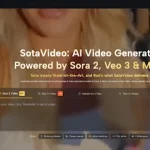2025 has officially been dubbed the “Year of AI Video.” In this technological arms race, two giants stand at center stage: OpenAI’s Sora 2 and Google DeepMind’s Veo 3.
For content creators, marketers, and filmmakers, the biggest confusion isn’t whether to use AI, but which model to choose. Sora 2 is renowned for its breathtaking physical simulations, while Veo 3 is celebrated for its deep understanding of cinematic language.
Today, we conduct a deep-dive comparison of these top-tier models across four key dimensions: Visual Fidelity, Physics Logic, Duration, and Control.
Core Philosophy: World Simulator vs. Cinematic Storyteller
Before diving into technical specs, we must understand the philosophical differences in their design. These distinct approaches dictate not just how the models look, but how they “think” about video generation.
Sora 2: The World Simulator
OpenAI defines Sora 2 not just as a video tool, but as a “World Simulator.” This distinction is critical. Its core strength lies in understanding how the physical world moves and interacts in three-dimensional space. Sora 2 isn’t merely predicting the next pixel in a sequence based on color data; it appears to be building an internal 3D representation of the scene. It simulates complex variables like light refraction, gravitational acceleration, fluid dynamics, and object collisions. When you ask for a video, Sora 2 is essentially running a high-fidelity physics engine in its neural network, prioritizing physical plausibility over narrative tropes.
Explore a related post offering added depth and fresh perspective worth reading.
Veo 3: The Cinematic Storyteller
Google has tailored Veo 3 more towards the established film industry and YouTube creators. Trained on vast amounts of cinematic footage and tagged video data, Veo 3 understands “camera language” and the grammar of film editing. It approaches video generation less like a physicist and more like a Director of Photography (DP). It knows how to execute a pan, tilt, or zoom like a seasoned cinematographer, prioritizing narrative flow, composition (such as the rule of thirds), and emotional lighting over raw simulation. Veo 3 understands that in movies, reality is often bent to serve the story.
Round 1: Visual Fidelity and Details
When it comes to static image quality, texture resolution, and microscopic details, Sora 2 remains the defending champion, pushing the boundaries of synthetic realism.
In our tests, we attempted to generate: “A dragon with complex iridescent scales breathing in a jewelry-filled cave, shot on 70mm film.”
- Sora 2’s Performance: The results were simply breathtaking, bordering on indistinguishable from reality. Sora 2 didn’t just render “shiny things”; it calculated the subsurface scattering of light penetrating the dragon’s organic scales. The reflection of firelight off each individual gem followed correct optical laws, and the atmospheric dust in the cave reacted to the light sources. It excels at high-frequency details—hair, fur, and particulate matter are rendered with distinct clarity rather than a “smudged” AI look.
- Veo 3’s Performance: Veo 3 produces high-quality 1080p/4K output that is broadcast-ready, but it slightly trails behind in extreme micro-details. If you pixel-peep, the textures on the dragon might appear slightly softer than Sora’s razor-sharp output. However, Veo 3 excels in “Color Science.” While Sora 2 sometimes outputs a raw, hyper-real look that can feel clinical, Veo 3’s output often carries a graded, filmic look right out of the box. It understands aesthetic concepts like “golden hour,” “teal and orange,” or specific film stocks, often requiring less post-production color correction to look “cinematic.”
Round 2: Physics Consistency and Motion
This is Sora 2’s home turf. The “World Simulator” architecture proves its worth when objects interact.
Test Case: “A cup of coffee spilling onto a table, flowing around a smartphone and a laptop.”
- Sora 2: The model demonstrated a frighteningly accurate understanding of fluid dynamics. It perfectly simulated the surface tension and flow direction of the liquid. Crucially, it understood Object Permanence and solidity: the coffee flowed around the obstacles rather than through them. The liquid pooled correctly, reflecting the environment on its surface. For VFX artists looking to replace expensive fluid simulations, Sora 2 is a game-changer.
- Veo 3: While it generated a visually smooth video, it struggled with the complex causal relationships of physics. In our test, the liquid occasionally “clipped” through the edge of the smartphone or morphed into the table texture. Veo 3 understands that liquid moves, but it doesn’t fully grasp the underlying laws of collision, leading to occasional “cartoon physics” where objects behave unlike their real-world material counterparts.
Round 3: Duration and Consistency
This is where Veo 3 strikes back hard. In professional production, a pretty 5-second clip is useless if the character turns into a different person in the next shot.
If you need to generate a long take exceeding 60 seconds, or require a character to maintain the exact same facial features across different scenes, Veo 3 is significantly more robust.
- Veo 3’s Context Mastery: Leveraging Google’s massive context window technology (derived from their Gemini architecture), Veo 3 can “remember” the character setup from the beginning of the clip. This allows for Temporal Coherence. You can generate a minute-long sequence where the protagonist walks through a door, and they are wearing the same shirt, have the same hairstyle, and retain the same facial structure. It drastically reduces the “morphing” or “face-swapping” hallucinations that plague most AI video models.
- Sora 2’s Dream Logic: Sora 2, while visually stunning in short bursts, can sometimes suffer from dream-like logic jumps over longer durations. As a video progresses past the 20-30 second mark, background elements might shift inexplicably, or a character’s clothing might slowly evolve. It operates like a vivid dream—intense and real in the moment, but lacking long-term memory.
Round 4: Directability and Control
For professional directors, control is everything. A random beautiful shot is less valuable than a specific shot that matches a storyboard.
- Veo 3: This model was built to take orders. It supports highly precise camera commands (e.g., “Pan Left,” “Zoom In,” “Truck Right,” “Rack Focus”). It understands lens choices (e.g., “50mm” vs “Fish-eye”). It adheres strictly to the director’s intent, making it easier to integrate into a storyboarded workflow where specific framing is required for continuity.
- Sora 2: Sora functions more like a creative partner than a tool. It supports camera controls, but it sometimes prioritizes “coolness” over strict adherence to the prompt. If you ask for a static tripod shot, but Sora calculates that a sweeping drone shot would look more dynamic given the subject matter, it might override your request. This “hallucinated creativity” is fantastic for brainstorming and inspiration, but it can be frustratingly challenging when trying to fulfill a strict commercial brief.
Conclusion
- Choose Sora 2 if: You seek maximum visual impact, are creating surrealist art, or require scenes with complex physical interactions (water, fire, explosions).
- Choose Veo 3 if: You are producing narrative shorts, need strict control over camera movement, or require character consistency over longer clips.
The Ultimate Solution
Why make compromises? At SotaVideo.ai, we have creatively aggregated both the Sora 2 and Veo 3 engines.
You can use Sora 2 to generate a stunning, physics-defying opening sequence, and then switch to Veo 3 to craft stable, narrative-driven dialogue scenes. SotaVideo.ai aims to dissolve the barriers between models, giving you access to both the “Physics Genius” and the “Cinema Master” in a single, unified workflow.
Discover more insights built to expand your thinking and inspire smarter choices.







